About The Artist
“If you wanna talk about influence, man, then you’ve got to realize that influence is not influence. It’s simply someone’s idea going through my new mind.”
– Jean-Michel Basquiat
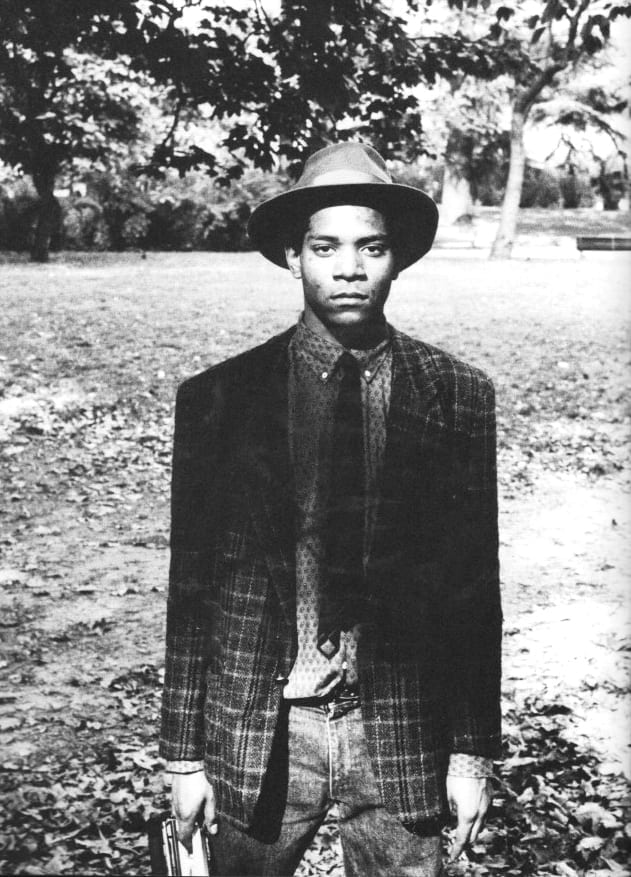
Photo by © Jean Kallina.
A Timeline
A chronological journey through the life of global legacy and prolific artist Jean-Michel Basquiat.
CHRONOLOGY
Originally compiled in 1992 by Franklin Sirmans for the Whitney Museum exhibition in New York. It was, since, updated for the 2017 Boom For Real exhibition at the Barbican Centre in London and, further, for the 2018 Fondation Louis Vuitton exhibition in Paris.
The Life & Legacy Of Jean-Michel Basquiat
Chronology from exhibition “Jean-Michel Basquiat” at the Whitney Museum of American Art, New York October 23, 1992-February 14, 1993
Compiled by M. Franklin Sirmans
Pictured Here: Philistines, 1982 © Estate Of Jean-Michel Basquiat
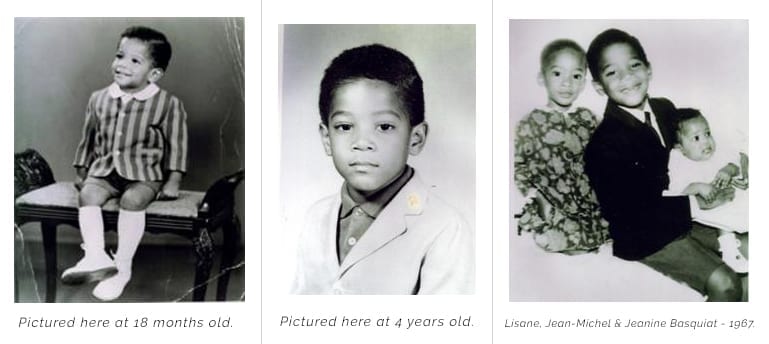
Early Life 1960 - 1970
1960
December 22, Jean-Michel Basquiat born at Brooklyn Hospital, New York. His father, Gerard Basquiat, born in Port-au-Prince, Haiti; his mother, Matilde Andrades, born in Brooklyn of Puerto Rican parents. The Basquiats live in Park Slope, Brooklyn.
1964
Sister, Lisane, is born in Brooklyn.
1964
At an early age, Basquiat shows an affinity for drawing, often using paper his father brings home from the accounting firm where he works to make drawings inspired by television cartoons. His mother has a strong interest in fashion design and sketching, and she frequently draws with Basquiat.
“His mother got him started and she pushed him. She was actually a very good artist” (Gerard Basquiat). 1
1965
With his mother, Basquiat often visits The Brooklyn Museum, The Museum of Modern Art, and The Metropolitan Museum of Art. His mother continues to encourage his interest in art and emphasizes the importance of education. Basquiat attends kindergarten at a Head Start Project school.
“I’d say my mother gave me all the primary things. The art came from her” (Basquiat). 2
1967
The Basquiat family moves to East 35th Street in the East Flatbush section of Brooklyn. Sister, Jeanine, is born.
1968
Basquiat continues to make cartoonlike drawings inspired by Alfred Hitchcock films, automobiles, comic books, and the Alfred E. Newman character from Mad.
“He was always so bright, absolutely an unbelievable mind …. He drew and painted all of his life from the time he was three or four years old” (Gerard Basquiat). 3

1969
In May, while playing ball in the street, Basquiat is hit by an automobile. He breaks an arm, suffers various internal injuries, and has to have his spleen removed. He is hospitalized at King’s County Hospital for one month. While recovering, he receives a copy of Gray’s Anatomy from his mother. The book makes a lasting impression; its influence is found in Basquiat’s later work with anatomical drawings and prints and in the name of the band he co-founded in 1979, Gray.
Gerard and Matilde Basquiat separate. The seven-year-old Basquiat lives with his father and two sisters in East Flatbush.
Image Credit: ‘Notes’ © The Estate of Jean-Michel Basquiat
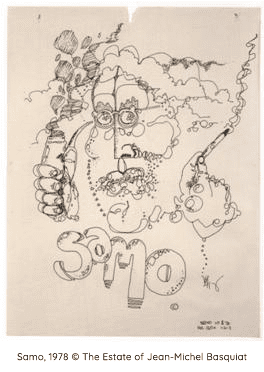
1971
Gerard Basquiat and his three children move to the Boerum Hill section of Brooklyn. Basquiat leaves St. Ann’s for public school, P.S. 181, the first of many New York City public schools he will attend, including P.S. 6, 101,45, and I.S. 293.
1974
Due to a job promotion and relocation, Gerard Basquiat moves with his three children to Mira Mar, Puerto Rico, near San Juan, where Basquiat attends an Episcopalian school.
1975
Basquiat runs away from home, staying for a few hours at a local radio station until the employees call his father, who immediately brings him home.
”Jean-Michel did not like obedience. He gave me a lot of trouble” (Gerard Basquiat).4
1976
On Thanksgiving Day, after a job transfer, Gerard Basquiat and his three children return from Puerto Rico to live in their Boerum Hill brownstone. Basquiat resumes schooling at Edward R. Murrow High School.
After a few weeks, he transfers to the City-as-School, a progressive school in Manhattan. Part of the New York City public school system, the City-as-School is an alternative high school where work-study internships are accepted as credit toward a high school degree. Designed for gifted and talented children who find the traditional educational process difficult, it is based on John Dewey’s theory that students learn by doing. At City-as- School, Basquiat meets Al Diaz, a graffitist from the Jacob Riis Projects on the Lower East Side; they become close friends and early artistic collaborators.
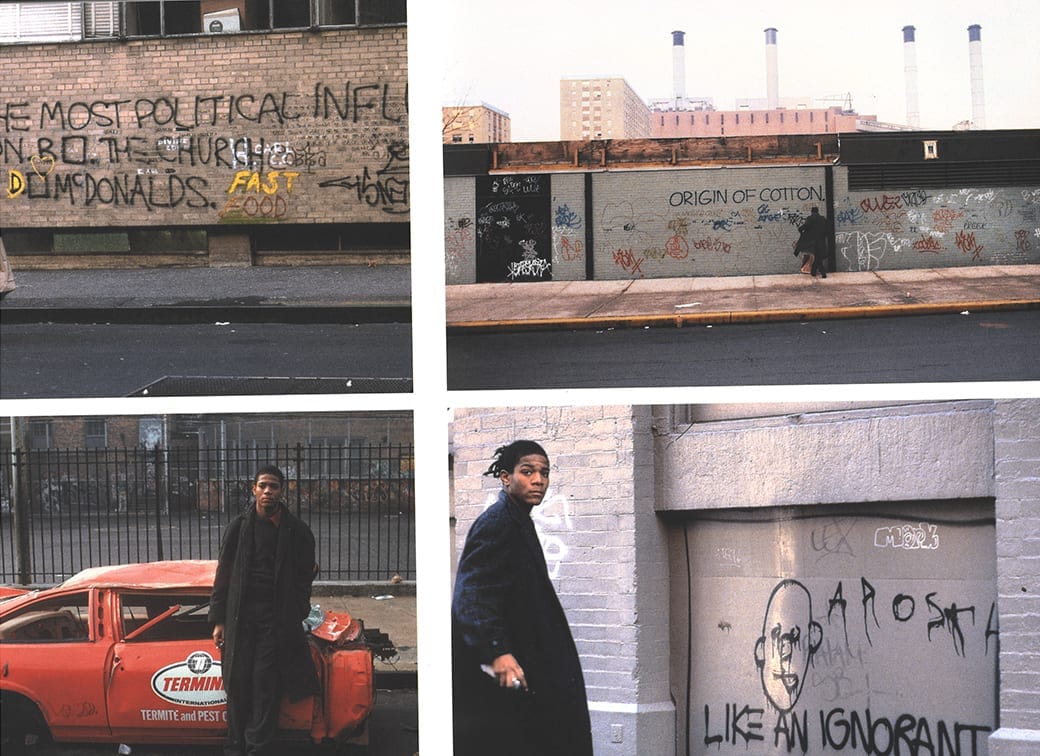
1976
In December, Basquiat again runs away, this time for about two weeks, hanging out in Washington Square Park in Greenwich Village, a place he and Diaz would often frequent. After much searching, Gerard Basquiat finds him and brings him home. Basquiat proclaims, “Papa, I will be very, very famous one day. 5
“I left home at 15, and went to Washington Square Park. I just sat there dropping acid …. Now that all seems boring; it eats your mind up” (Basquiat). 6
Photo Credit: Downtown 81 (New York Beat) © New York Beat Film LLC.© The Estate of Jean-Michel Basquiat Photo by Edo Bertoglio
1977
Through the City-as-School, Basquiat becomes involved with an Upper West Side drama group called Family Life Theater. During this time, he creates a fictional character named SAMO (Same Old Shit), who makes a living selling a fake religion. Basquiat and Diaz, among the most popular students at City-as-School, both very creative and with a knack for getting into a lot of trouble, begin collaborating on the SAMO project as “a way of letting off steam.” 7
They begin spray-painting aphorisms on the D train of the IND line and around lower Manhattan. The writings consist of witty philosophical poems: SAMO as an end to mindwash religion nowhere politics, and bogus philosophy,” “SAMO saves idiots, Plush safe he think; SAMO.
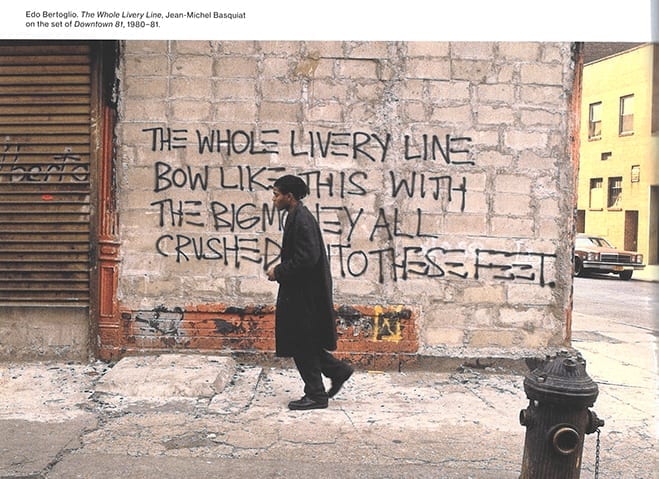
1977
“The stuff you see on the subways now is inane. Scribbled. SAMO was like a refresher course because there’s some kind of statement being made” (Al Diaz). 8
Nora Fitzpatrick begins residing with Gerard Basquiat. She becomes a maternal figure, and friend, to the younger Basquiat.
At Diaz’s graduation from the City-as-School in June, Basquiat, on a dare, prepares a box full of shaving cream, and while the principal is speaking he runs up to the podium and dumps the box on his head. Although only a year away from graduating, Basquiat feels there is “no point in going back.” 9
Photo Credit: Downtown 81 (New York Beat) © New York Beat Film LLC.© The Estate of Jean-Michel Basquiat Photo by Edo Bertoglio
1978
In June, Basquiat leaves home for good. Gerard Basquiat, with some trepidation, gives his son money with the understanding that he will try his best to succeed.
Basquiat’s fascination with stardom and “burning out” is a recurring subject in his life. Jimi Hendrix and Janis Joplin, two people whose work and artistic achievement Basquiat admires, had both died of drug overdoses at the age of twenty- seven in 1970. His admiration for musicians, singers, and boxers like Joplin, Hendrix, Charlie Parker, Billie Holiday, Sugar Ray Robinson, and Joe Louis is shown later in various paintings.
“Jean-Michel was planning to be a star” (Gerard Basquiat). 10
“Since I was seventeen, I thought I might be a star. I’d think about all my heroes, Charlie Parker, Jimi Hendrix …. I had a romantic feeling of how people had become famous” (Basquiat). 11

1978
Basquiat stays at the homes of various friends, frequently at the Canal Street loft of British artist Stan Peskett, who throws parties that bring the uptown graffitists, including Fred Braithwaite and Lee Quinones, downtown, although more for the exchange of musical ideas than art. At these parties, Basquiat also meets Michael Holman, a future member of Gray, and Danny Rosen, who immediately becomes a companion on the downtown club scene. Basquiat, Rosen, Holman, and Vincent Gallo, who would also join Gray, are referred to as the “baby crowd” at the clubs.
“They were gorgeous, extremely stylish, and danced fantastically” (Edit DeAk).12
Photo Credit: Basquiat with Untitled (Julius Caesar on Gold) (1981; left) and Untitled (L.A. Painting) (1982; ground), New York, c. 1981 © Pierre Houlès
1978
Basquiat begins to sell hand-painted postcards and T-shirts to make a little money. He approaches Andy Warhol and Henry Geldzahler inside the SoHo restaurant WPA; he sells a postcard to Warhol but Geldzahler dismisses him as “too young.” 13
Basquiat begins dating Alexis Adler and the two often stay together at friends’ houses in downtown Manhattan. They live for a while in the apartment of their close friend Felice Ralster, until Basquiat becomes unbearable because he writes and draws over everything in the apartment.
“Basquiat painted on anything he could get his hands on: refrigerators, laboratory coats, cardboard boxes, and doors” (Mary Ann Monforton). 14
1978
Basquiat and Adler move into a small apartment at 527 East 12th Street, his first fixed address. During this time, he becomes a regular among a crowd of filmmakers, musicians, and artists that hang out at the “new” downtown spots: the Mudd Club, Club 57, CBGB’s, Hurrah’s, and Tier 3. Along with Patti Astor, co-founder of the Fun Gallery, David Byrne, Blondie, Madonna, Tina Lhotsky, the B-52s, John Lurie, Diego Cortez, Edit DeAk, Ann Magnuson, and John Sex, Basquiat regularly makes the scene at the Mudd Club.
At the same time, a cultural aesthetic is flowering uptown in the streets of Harlem and the basements of the South Bronx: rap, graffiti, and breakin’ -the roots of hip-hop culture. Fred Braithwaite notes that “the scene downtown … was pretty much all white except for me, Jean-Michel, and a few other people.”15
As Basquiat saw it, “there’s not enough black people downtown in this … whatever it is, pseudo art bullshit.” 16
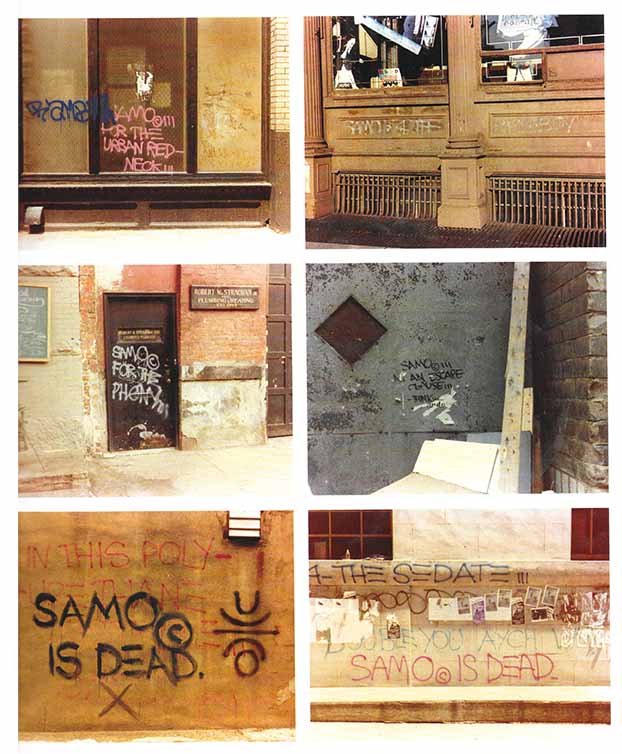
1979
Shortly after the article in The Village Voice, Basquiat and Diaz have a falling out that ends the SAMO collaboration, and “SAMO is dead” begins appearing on various SoHo walls.
“Jean-Michel saw SAMO as a vehicle, the graffiti was an advertisement for himself. … all of a sudden he just started taking it over” (Al Diaz). 20
Basquiat concentrates on painting T-shirts and making postcards, drawings, and collages. They display a combination of graffiti art and Abstract Expressionism, and focus on baseball players, the Kennedy assassination, and consumer items such as Pez candy. Basquiat collaborates on many of these with John Sex and Jennifer Stein, and sells the work in Washington Square Park, around SoHo, and in front of The Museum of Modern Art.
Photo Credit: Henry Flynt ‘The SAMO© Graffiti Portfolio, 1979-91’, ‘Boom For Real’ Catalogue
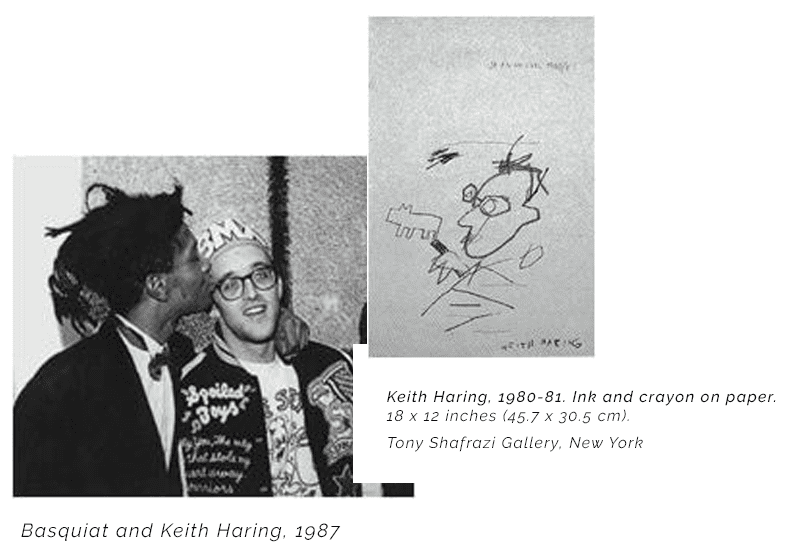
1979
In May, Basquiat, along with Michael Holman, Shannon Dawson, and Vincent Gallo form the band Channel 9, later renamed Test Pattern, then Gray. They are subsequently joined by Wayne Clifford and Nick Taylor. Basquiat plays clarinet and synthesizers for the group, which performs a distinct blend of jazz, punk, and synth-pop, often referred to as “noise music.”
“It wasn’t about the level of playing, it was about the sound”
(Michael Holman) .21
In the fall, while wandering around the School of Visual Arts, Basquiat meets fellow artists and downtown scenemakers Keith Haring and Kenny Scharf. Haring and Scharf are as much a part of the scene at Club 57 as Basquiat is at the Mudd Club. Basquiat and Haring share an on-again, off-again relationship for the rest of their lives. Basquiat admires the raw, graffiti qualities of Haring’s work, and he sees Haring as truly a part of the graffiti subculture in a way that he is not. After reading “SAMO is dead,” Haring per- forms a eulogy for SAMO at Club 57. In 1988, Haring paints A Pile of Crowns for Jean-Michel Basquiat as a memorial to Basquiat.
1979
Through Fred Braithwaite, Basquiat meets Glenn O’Brien, the producer of TV Party on New York cable television and music editor at Interview. They become good friends, and Basquiat frequently appears on O’Brien’s TV Party.
At the Mudd Club, Basquiat meets Diego Cortez, an artist and filmmaker, who knows people within and outside of the East Village club scene. Cortez takes a liking to Basquiat’s work, sells some drawings, and eventually shows the work to art dealers. He also formally introduces Basquiat to Henry Geldzahler, who becomes a friend and early collector of Basquiat’s art.
“Diego had done a lot … some performance stuff with Laurie Anderson. He was one of the few people who had contacts in both music and art at the Mudd Club”(Glenn O’Brien).22
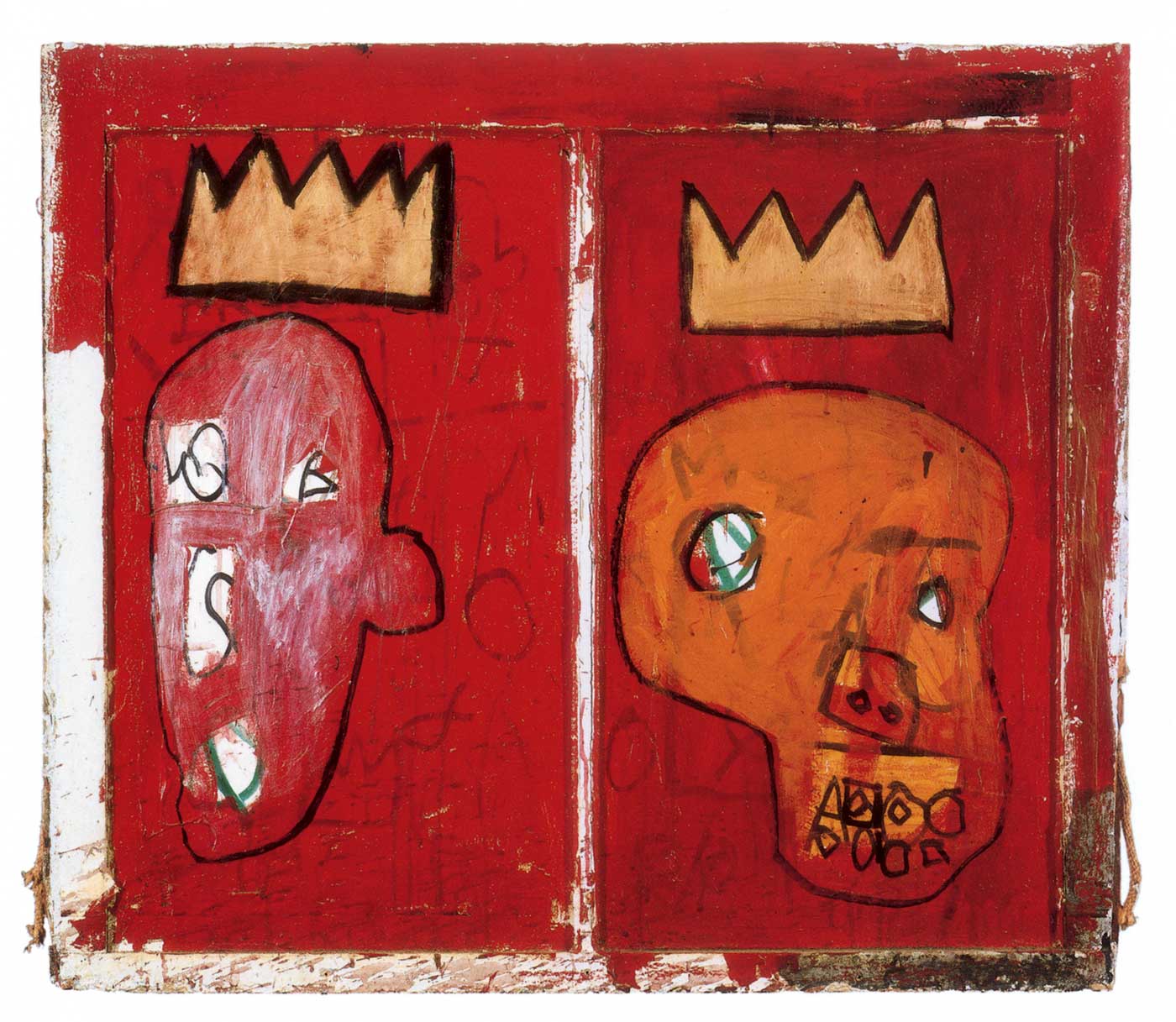
1980
In June, Basquiat’s art is publicly exhibited for the first time in the “Times Square Show,” a group exhibition held in a vacant building at 41st Street and Seventh Avenue in the Times Square area of New York. The exhibition is organized by Colab (Collaborative Projects Incorporated), an artist-run group based on the Lower East Side, and Fashion Moda, a graffiti-based alternative gallery space in the South Bronx. Like members of the two organizing groups, the conjunction of artists in the show represents two very distinct subcultures: the downtown avant-garde consisting of new wave and neo-pop, and the uptown avant-garde of rap and graffiti.
Some of the other artists in the show are: John Ahearn, Jane Dickson, Mike Glier, Mimi Gross, David Hammons, Jenny Holzer, Joe Lewis, Candace Hill-Montgomery, Tom Otterness, Lee Quinones, Kenny Scharf, Kiki Smith, and Robin Winters.
Photo Credit: Red Kings, 1981 © The Estate of Jean-Michel Basquiat
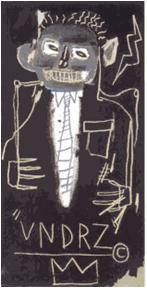
1980
The “Times Square Show” is enthusiastically received by the art world, an early step in legitimizing the artists of the East Village club scene. Basquiat creates a large SAMO installation on a single wall of the space and is one of a few artists discussed in the review for Art in America.
“A patch of wall by SAMO, the omnipresent graffiti sloganeer, was a knock- out combination of de Kooning and subway spray-paint scribbles” (Jeffrey Deitch). 23
Encouraged by the recognition of his artistic talent, Basquiat announces that he is quitting Gray, and the band plays for the last time at the Mudd Club on August 3.
Pictured Here: VNDRZ, 1982 © The Estate of Jean-Michel Basquiat
1981
In January, Basquiat and his girlfriend, Suzanne Mallouk, a singer and artist, begin sharing an apartment at 68 East lst Street.
In February, Basquiat is included in “New York/New Wave,” an exhibition organized by Diego Cortez for the large gallery space at P.S. 1, Institute for Art and Urban Resources, in Long Island City. The show includes more than twenty artists, among them Edie Baskin, Keith Haring, Robert Mapplethorpe, Kenny Scharf, Andy Warhol, and the graffiti artists Ali, Crash, Dondi, Fab 5 Freddy (Braithwaite), Haze, Lady Pink, Seen, and Zephyr. Basquiat has high visibility in the show, with a wall on which he installs more than twenty drawings and paintings. These works attract the attention of dealers Emilio Mazzoli, Bruno Bischofberger, and Annina Nosei. The day after the opening of the show, Basquiat returns home to Brooklyn around six in the morning and proclaims, “Papa I’ve made it!” 24
Immediately after the P.S. 1 show, Haring organizes the “Lower Manhattan Drawing Show” at the Mudd Club, for which he selects more than seventy artists, including Basquiat, Charlie Ahearn, Donald Baechler, Fred Braithwaite, Crash, Jane Dickson, Futura 2000, Joe Lewis, Judy Rifka, Kenny Scharf, and Sir Rodney Sur.
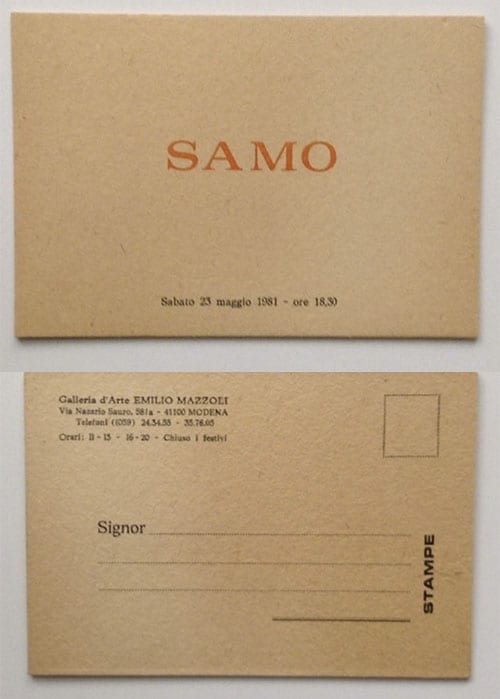
1981
In May, Basquiat travels to Europe for the first time, for his first one-artist exhibition, at the Galleria d’Arte Emilio Mazzoli in Modena, Italy. The work is shown under the name SAMO.
Basquiat is invited by Annina Nosei to participate in the group show “Public Address” at her gallery in September. Sociopolitical content is the focus of the exhibition, with works by Bill Beckley, Mike Glier, Keith Haring, Jenny Holzer, Barbara Kruger, and Peter Nadin. Basquiat is given the entire rear gallery for his paintings, whose subjects include policemen, rabbis, and Native Americans. Following this exhibition, Nosei becomes Basquiat’s primary dealer and, knowing he has no studio space of his own, invites him to use her gallery basement space as a studio.
Pictured Here: “SAMO”, FIRST ONE MAN SHOW, Exhibit Invitation Card, Galleria d’Arte Emilio Mazzoli Italy, 1981 © The Estate of Jean-Michel Basquiat
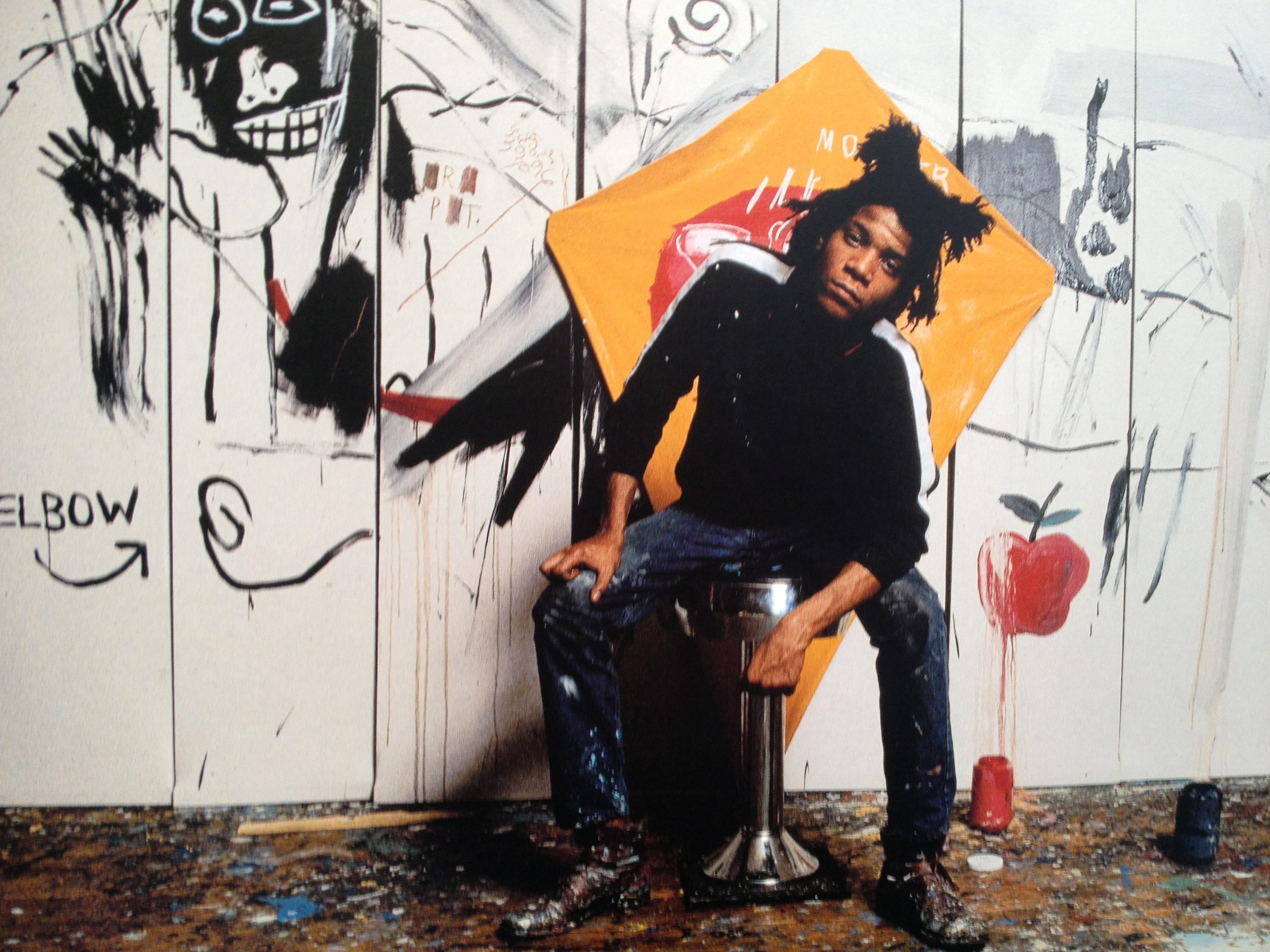
1981
The first extensive article on Basquiat, “The Radiant Child,” by Rene Ricard, appears in the December 1981 issue of Artforum. The detailed essay examines the emerging New York artists from the Mudd Club shows, the “Times Square Show,” and “New York/New Wave.” Some of the other artists discussed are John Ahearn, Fred Braithwaite, Francesco Clemente, Dondi, Futura 2000, Keith Haring, Lady Pink, and Judy Rifka.
“I’m always amazed by how people come up with things. Like Jean- Michel. How did he come up with those words he puts all over every-thing.? Their aggressively handmade look fits his peculiarly political sensibility …. Here the possession of almost anything of even marginal value becomes a token of corrupt materialism …. The elegance of Twombly is there but from the same source (graffiti) and so is the brut of the young Dubuffet” (Rene Ricard). 25
Photo Credit: Jean-Michel Basquiat in his studio, New York 1982. Photo by Gianfranco Gorgoni © Maya Gorgoni
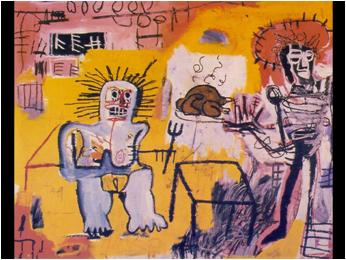
1982
In January, Basquiat moves with Suzanne Mallouk to 151 Crosby Street in SoHo, an apartment that Nosei arranges for Basquiat.
Basquiat meets Shenge Kapharoah, an artist from Barbados. The two become inseparable friends, sharing interests in African ideologies and the concerns of artists within the African diaspora, subjects that were not of interest to many of Basquiat’s friends.
“You can see our friendship in the work. The paintings speak for them- selves … Moses and the Egyptians, Charles the First, lines like ‘most kings get their heads chopped off. ‘ This is what we were talking about” (Shenge Kapharoah). 26
In March, Basquiat has his first one-artist exhibition in the United States at the Annina Nosei Gallery. Paintings in this show include Arroz con Pollo, Self-Portrait, Untitled (Per Capita), and Untitled (Two Heads on Gold). The exhibition is a huge success.
Pictured Here: Arroz con Pollo, 1981 © Collection of Felipe Grimberg.
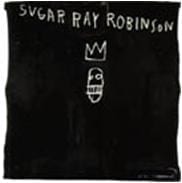
1982
In April, Basquiat travels to Los Angeles for his solo show at the Larry Gagosian Gallery, arranged by Gagosian with Annina Nosei. Paintings exhibited include Six Crimee, Untitled (LA Painting), and Untitled (Yellow Tar and Feathers).
“The traditional substructure of Basquiat’s art is Abstract Expressionism. He piles up rich palimpsests of paint over black grounds or snazzy oranges that are structured with architectonic solidity …. There is never any sense that Basquiat is faking” (William Wilson). 29
Pictured Here: Untitled (Sugar Ray Robinson), 1982 © Estate of Jean-Michel Basquiat; courtesy of Robert Miller Gallery, New York
1982
Basquiat stays at the Chateau Marmont and at friends’ houses for about six months. He likes the Los Angeles climate and club scene and is given a friendly initial reception among Los Angeles collectors; Eli and Edythe Broad, Douglas S. Cramer, and Stephane Janssen become early collectors of Basquiat’s work. He returns to Los Angeles at least two or three times a year for the rest of his life.
In June, Basquiat, at age twenty-one, is the youngest of 176 artists invited to participate in the international exhibition “Documenta 7” in Kassel, West Germany. His work is shown with that of such established artists as Joseph Beuys, Anselm Kiefer, A. R. Penck, Gerhard Richter, Cy Twombly, and Andy Warhol, in addition to that of younger artists Francesco Clemente, Keith Haring, Jenny Holzer, Lee Quinones, and David Salle. Among the paintings shown are Acque Pericolose (Poison Oasis) and Arroz con Pollo.
“Jean-Michel Basquiat … has an inbred compositional sense that verges on good taste, as was particularly evident in his Documenta canvas Acque Pericolose …. his strength comes not so much from the social- commentary aspect of his work (although he has made some unforgettable saints and sinners) … but from his Twomblyesque lyrical qualities” (Noel Frackman and Ruth Kaufmann). 30
1982
Basquiat creates his first portfolio of prints, titled Anatomy. It consists of eighteen silkscreens on paper in an edition of eighteen with seven artist’s proofs, printed by Jo Watanabe and published by the Annina Nosei Gallery.
His first one-artist exhibition at the Galerie Bruno Bischofberger in Zurich opens in September. This exhibition marks the first showing of Basquiat’s exposed corner crossbar paintings. Bischofberger becomes his exclusive dealer in Europe.
In October, an Art in America article by Suzi Gablik entitled “Report from New York: The Graffiti Question” features Basquiat, Braithwaite, Futura 2000, Haring, and Quinones, among others, identifying them as part of the new “graffiti movement” and discussing the emergence of the Lower East Side art scene. The piece is an early attempt to label artists of the 1980s. Basquiat, however, was not a representative graffiti artist because his written messages as SAMO did not share the formal concerns of graffiti artists, namely, their colorful palette.
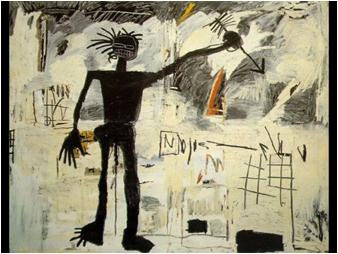
1982
Nevertheless, because he is young and because he is black, Basquiat’s paintings and drawings encourage the recognition of graffiti art within the art world. By this time, the Lower East Side arts scene has graduated from exhibitions in clubs to small storefront alternative gallery spaces that exhibit hundreds of young artists from the downtown club scene, artists who were rarely accepted by the larger art community of New York. Among these alternative venues are the Fun Gallery, East Seventh Street Gallery, Kenkeleba House, Gracie Mansion, B-Side, Area-X, and Civilian Warfare.
By the fall of 1982, personal differences have brought Basquiat’s relationship with Annina Nosei almost to an end. He works feverishly in his studio apartment on Crosby Street.
I had some money; I made the best paintings ever. I was completely reclusive, worked a lot, took a lot of drugs. I was awful to people.” 31
Pictured Here: ‘Self-Portrait,’ 1982 © Collection of Bo Franzen
1982
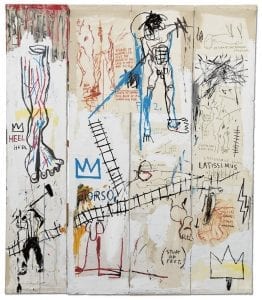
Pictured Here: Leonardo Da Vinci’s Greatest Hits, 1982 © Collection of Jonathan Schorr
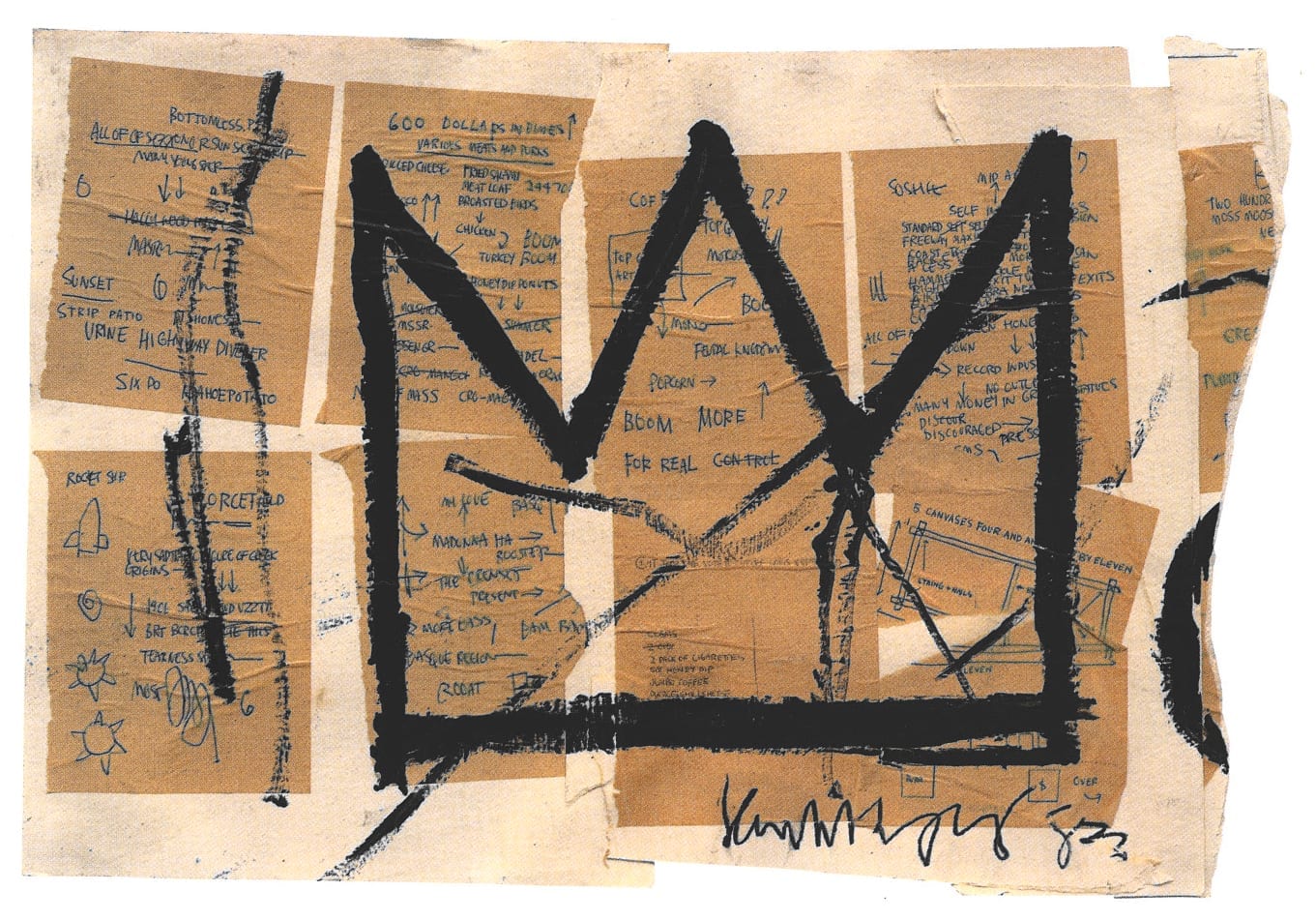
1982
In November, Basquiat has a one-artist exhibition at the Fun Gallery, located at 254 East 10th Street and run by Bill Stelling and Patti Astor. Paintings in the show are severely underpriced with no regard for Basquiat’s present market value. This show, held contrary to the advice of Annina Nosei marks the end of Basquiat’s association with his first American dealer. The canvases reveal a terrific rawness in a crowded installation designed by Basquiat. The “messy” character of the installation may have been Basquiat’s response to criticism that, with his rising international fame and “cleaner” shows in the more finished spaces of SoHo galleries, his work had lost some of its originality. The paintings in this show, the fruit of his hermetic season in the Crosby Street loft, prove the critics wrong.
The show included approximately thirty works, among them Cabeza, Charles the First, Jawbone of an Ass, Three Quarters of Olympia Minus the Servant, and Untitled (Sugar Ray Robinson), which were among his favorites and which he kept for his personal collection.
“Gut emotions lie behind the phrases and images, not the desire to make neo-expressionist commodities …. Basquiat makes paintings, but eschews the medium’s traditional rules” (Susan Hapgood). 32
Pictured Here: Untitled (Crown) 1982 © The Estate of Jean-Michel Basquiat
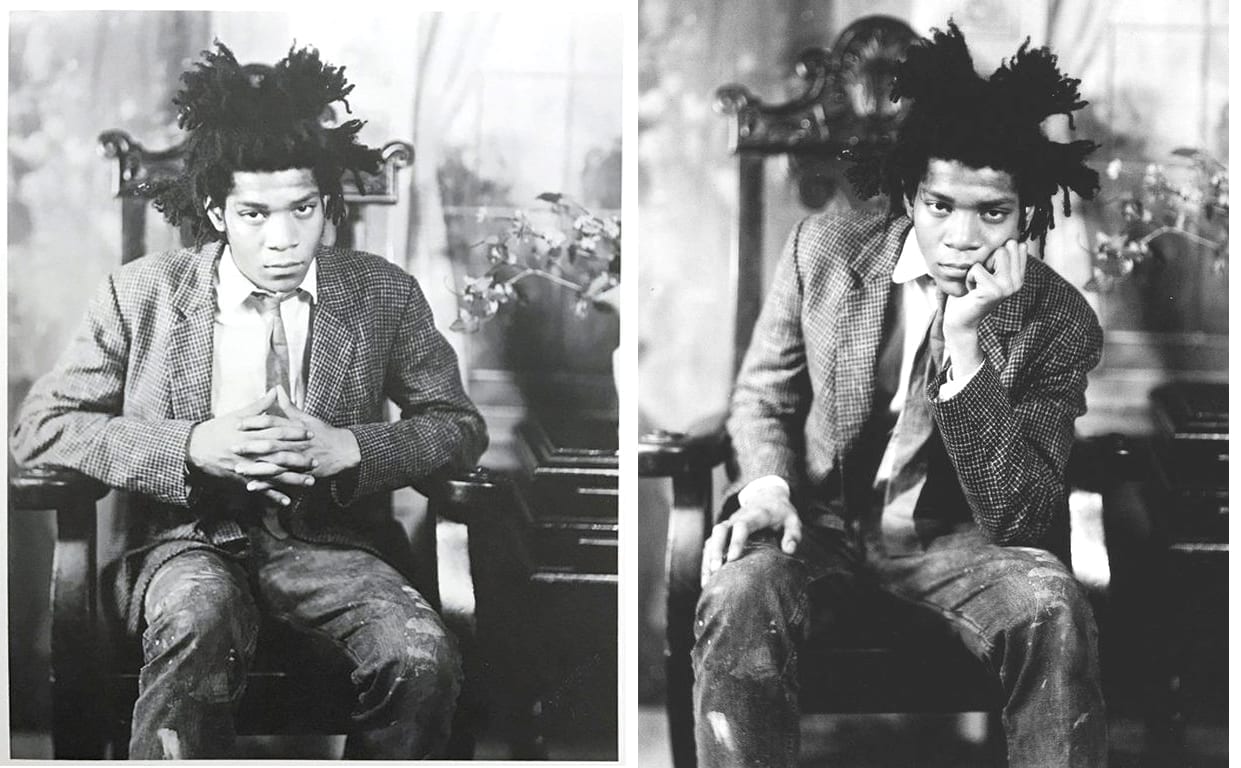
1982
“Jean-Michel Basquiat’s show at the Fun Gallery was his best show yet. He was at home; the hanging was perfect, the paintings more authentic than ever” (Nicolas A. Moufarrege).33
Basquiat poses for the renowned photographer James Van Der Zee, famous for his documentary photos of the Harlem Renaissance and his portraits of the artists, singers, and writers of the period. Basquiat grows to admire the elder Van Der Zee and later paints his portrait. The photo session with Van Der Zee is arranged by Diego Cortez to accompany Henry Geldzahler’s interview with Basquiat for Interview. This photo portrait places Basquiat in a geneaological line with other black artists of the twentieth century.
In December, Basquiat’s paintings are presented in a one-artist exhibition at the Galerie Delta in Rotterdam. In these works, like those in the Fun Gallery show, the crossbars of the stretcher corners are exposed and often hung on the wall by twine. LNAPRK and Kings of Egypt are among the paintings in the show.
With Rammellzee and graffiti artist Toxic, Basquiat returns to California. He spends part of winter 1982-83 in Los Angeles, often staying at the L’Ermitage hotel and dining with friends at Mr. Chow’s in Beverly Hills. He frequently gives paintings to Michael and Tina Chow, in return for food and drink.
Photo Credit: James Van Der Zee. Jean-Michel Basquiat, 1982. Estate of James Van Der Zee; courtesy Donna Van Der Zee
1982
Larry Gagosian introduces Basquiat to Fred Hoffman, an art dealer and admirer of Basquiat’s work. Basquiat, with Hoffman’s help, produces five editions of prints, published in 1983 by New City Editions in Venice, California. Printed by Joel Stearns, the editions consist of three Untitled sets along with Back of the Neck and the 8-foot-tall Tuxedo.
Basquiat’s interest in music continues. He produces a rap record with Fred Braithwaite, Toxic, A-One, Al Diaz, and Rammellzee and often dj’s at various Manhattan clubs. Some of his paintings-Charles the First, CPRKR, Discography (One), Discography (Two), Horn Players, and Max Roach-express his strong affinity for the work of the jazz artists Miles Davis, Dizzy Gillespie, Billie Holiday, Charlie “Bird” Parker, and Max Roach. Basquiat’s literary preferences include William Burroughs and Jack Kerouac.
The interest in jazz for Jean-Michel began with his father, then the personality of these characters and how they developed in their worlds, which he saw as similar to his own, particularly Parker and Holiday (Shenge Kapharoah).34
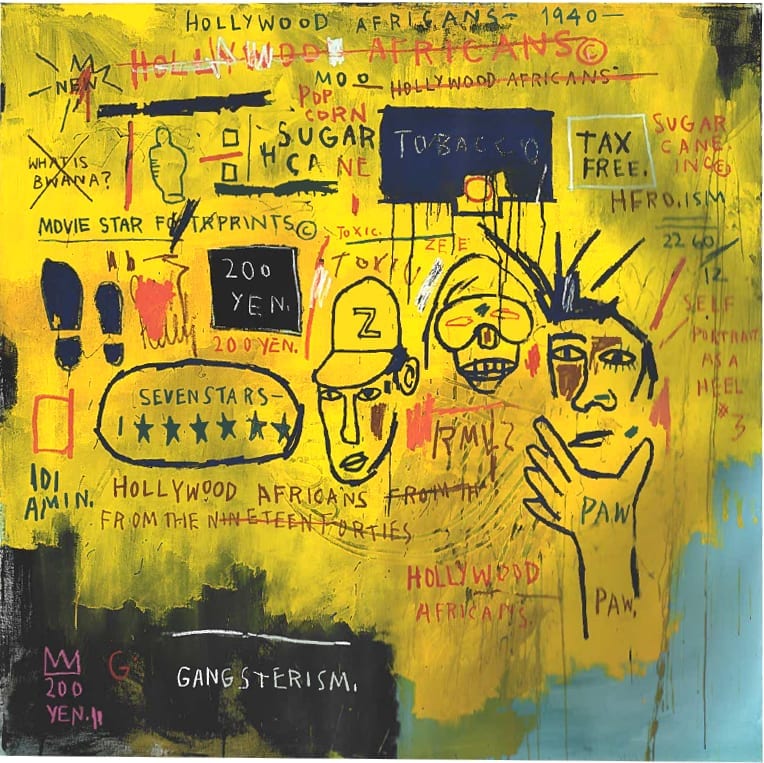
1983
In February, Annina Nosei presents a one-artist exhibition of Basquiat’s work that includes Untitled and the Anatomy print portfolio.
In March, Basquiat returns to Los Angeles for his second show at the Larry Gagosian Gallery. Paintings include Untitled (Sugar Ray Robinson), Jack Johnson, Horn Players, Eyes and Eggs, Hollywood Africans, and All Colored Cast (Parts I and II). They feature texts and images related to famous boxers, musicians, and Hollywood films and the roles played by blacks in them.
Also in March, Basquiat is included in the 1983 Biennial Exhibition” at the Whitney Museum of American Art, New York. The exhibition includes more than forty artists, many being shown for the first time at the Museum, among them Keith Haring, Jenny Holzer, Barbara Kruger, David Salle, and Cindy Sherman. Basquiat, at age twenty-two is one of the youngest artists ever to be included in a Whitney Biennial. The two works exhibited are Dutch Settlers and Untitled (Skull).
We got tickets for the opening of the New Art show at the Whitney, the Biennial. And the show is just like the sixties …. These kids are selling everything-Jean-Michel Basquiat’s show sold out in Los Angeles” (Andy Warhol). 35
Pictured Here: Hollywood Africans, 1983, © The Estate of Jean-Michel Basquiat
1983
In May, Basquiat, Toxic, and Nick Taylor leave New York for a week in Jamaica, where Basquiat often draws in his hotel room and carries notebooks and writing tablets that he fills with cryptic notes and small drawings.
On August 15, Basquiat moves into 57 Great Jones Street, a building he leases from its owner, Andy Warhol. Their relationship flowers, though it prompts much discussion of white patronization of black art. Warhol and Basquiat work out together, paint each other’s portraits, attend art events, and regularly discuss philosophies of life and art, as well as Basquiat’s family experiences. Warhol encourages Basquiat to be more responsible toward his family.
“Wanted Jean-Michel to come over and paint, but he was giving his mother a birthday party so I went to meet him and met his mother. She’s a nice-looking lady …. she was really nice and everything” (Andy Warhol). 36
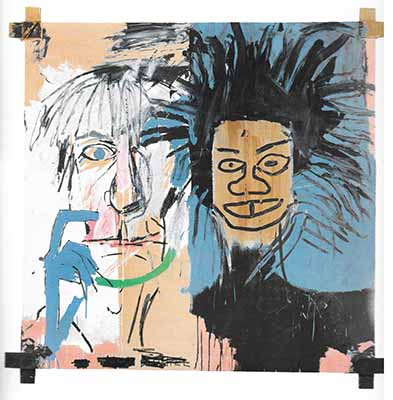
1983
“One thing that affected Jean-Michel greatly was the Michael Stewart story …. He was completely freaked out. It was like it could have been him. It showed him how vulnerable he was” (Keith Haring). 39
“It could have been me, it could have been me” (Basquiat). 40
In October, Basquiat and Warhol leave New York for Milan. Basquiat spends time in Madrid and Zurich as well as a week in Tokyo with dealer Bruno Bischofberger to attend a November exhibition of his work at the Akira Ikeda Gallery.
Basquiat returns to New York in November. He, Warhol, and Francesco Clemente begin working on collaborative paintings in New York, an endeavor arranged by Bruno Bischofberger. Basquiat and Warhol also execute their own collaborative paintings.
“Jean-Michel came up to the office but he was out of it. Clemente brought up some of the paintings that the three of us are working on together, and Jean-Michel was so out of it he began painting away. Jean-Michel and Clemente paint each other out. There’s about fifteen paintings that we’re working on together” (Andy Warhol). 41
Pictured Here: Dos Cabezas, 1982 © The Estate of Jean-Michel Basquiat
1983 - 84
Basquiat returns to Los Angeles in December, where he stays at L’Ermitage Hotel and spends time with Madonna, an acquaintance from the East Village and the Mudd Club. Through Larry Gagosian and Fred Hoffman, Basquiat rents a studio on Market Street in Venice, California, where he begins a series of paintings on wood panels, assisted by Matt Dike, a friend and Los Angeles dj. These paintings, later shown at the Mary Boone Gallery in New York, include Flexible, Water-Worshipper, and Gold Griot.
By the end of the year, Bischofberger in Switzerland is Basquiat’s only primary dealer. Problems with dealers have become a recurrent feature of Basquiat’s career.
Responding to a question about whether it is harder to get along with girlfriends or dealers, Basquiat replies, “They’re about the same actually.” 42
In January, Basquiat leaves Los Angeles for Maui, Hawaii, a place that he thenceforth frequents. He rents a ranch on a remote part of the island, three hours from the airport in the town of Hana, where he sets up a studio to make drawings and paintings with materials sent from Los Angeles. In February, Paige Powell, his sister Jeanine, Nora Fitzpatrick, and Gerard Basquiat come to visit. Exceedingly generous, he also flew in what his father called “a planeload of freeloaders.43
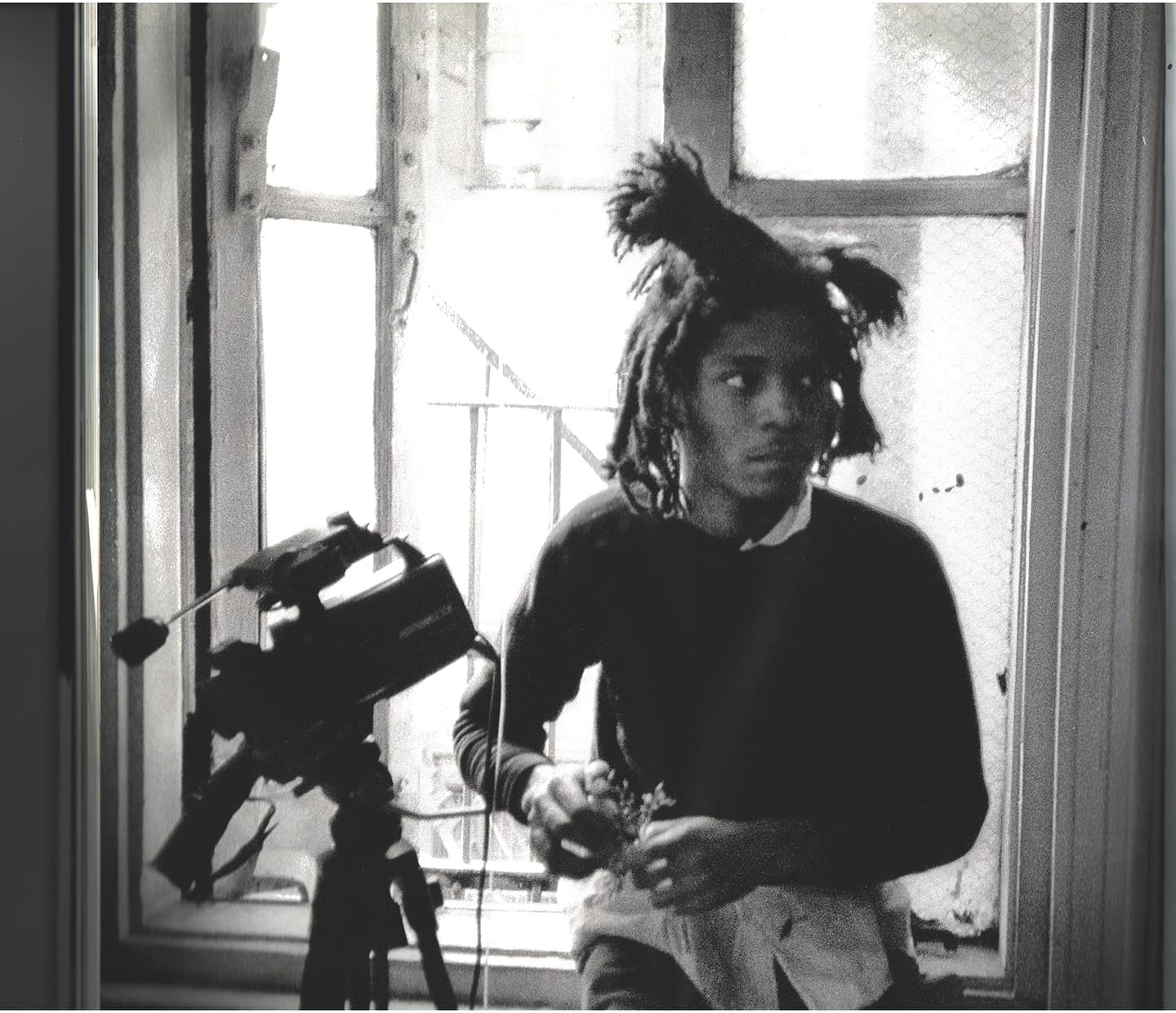
1983 - 84
Basquiat returns to New York in March. Although skeptical about affiliating himself with another dealer he joins the Mary Boone Gallery.
“He was very unsure of this prospect, though he considered it a good career move, he was not interested in the idea of becoming an artist for another dealer” (Paige Powell). 44
Boone and Bischofberger become Basquiat’s primary dealers. Boone is also the dealer for Eric Fischl, David Salle, and Julian Schnabel, while Bischofberger, European dealer for Andy Warhol, also represents the European Neo-Expressionists- Sandro Chia, Francesco Clemente, and Gerhard Richter. Boone and Bischofberger organize joint exhibitions for Basquiat.
Photo Credit: Jean-Michel Basquiat, 1983 © Roland Hagenberg
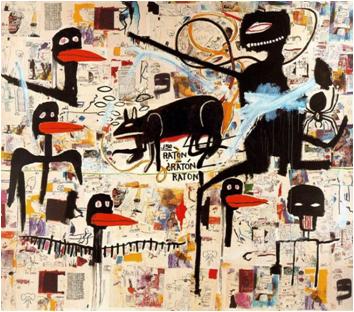
1984
In May, Basquiat has his first one-artist exhibition at the Mary Boone Gallery. Paintings include Bird as Buddha, Brown Spots, Eye, Untitled (Africa), and Wine of Babylon. The show was met by mixed reviews.
“The early work is of an original primitivism, with a graffiti heritage. The originality has quickly become stylized and somewhat self-conscious in this current show” (Donald Kuspit), 45
“The young artist uses color well …. But more remarkable is the educated quality of his line and the stateliness of his compositions, both of which bespeak a formal training that, in fact, he never had” (Vivien Raynor).” 46
“And throughout floated a disembodied eye, which seemed to allude both to the self-the ‘I’-and to the witness or seer. But one sensed little of what Basquiat is witness to, or of why it bears accounting” (Kate Linker). 47
Also in May, Basquiat is included in An International Survey of Recent Painting and Sculpture at The Museum of Modern Art, New York, which inaugurates the reopening of the museum.
Pictured Here: Tenor, 1985 © The Estate of Jean-Michel Basquiat
1984
At Christie’s spring auction of contemporary paintings, a 1982 Basquiat canvas, Untitled (Skull), fetches a record $19,000. The painting had originally been purchased for $4000 the year before. Remarkable for any twenty-three-year old artist, this auction price is all the more noteworthy for an artist of color.
In August, Basquiat’s first museum exhibition opens at the The Fruitmarket Gallery, Edinburgh. Organized by Mark Francis, the exhibition surveys paintings from 1981 to 1984 and travels to the Institute for Contemporary Arts, London, and the Boymans- van Beuningen Museum, Rotterdam.
In September, Basquiat’s collaborative paintings with Warhol and Clemente are shown at the Galerie Bruno Bischofberger in Zurich. The trio had completed about fifteen paintings and this show demonstrates the degree of celebrity status and popularity that Basquiat has attained at such an early age.
1984
Though Basquiat’s acceptance within the smaller art community of people of color has not been very warm, he is included in the exhibition “Since the Harlem Renaissance: 50 Years of Afro- American Art,” organized by the Center Gallery of Bucknell University, Lewisburg, Pennsylvania. The two works shown, Danny Rosen and Untitled, are installed in the section “Self-Taught to Neo-Expressionism,” along with the work of graffiti artists Blade, Dondi, and Futura 2000, the self-taught artists William Hawkins and Bill Traylor, and the expressionists Robert Colescott and Bob Thompson. Other artists include Romare Bearden, Elizabeth Catlett, Ed Clark, Sam Gilliam, David Hammons, Palmer Hayden, William H. Johnson, Jacob Lawrence, Norman Lewis, Joe Overstreet, Howardena Pindell, Betye Saar, and Alison Saar.
Late in 1984, Basquiat meets Jennifer Goode, sister of the owner of the New York club Area. This relationship is said to be one of the most serious romantic affairs of Basquiat’s life.
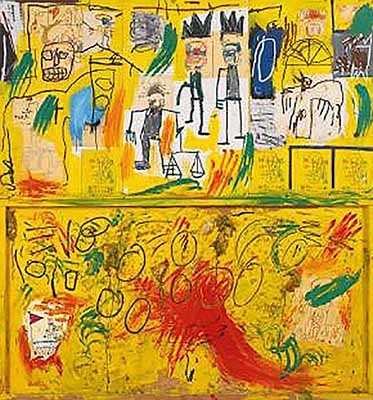
1984
Basquiat’s friends become more and more concerned about his excessive drug use. They often find Basquiat in a state of paranoia and uncharacteristically unconcerned with his appearance. Basquiat’s paranoia is also fueled by the very real threat of people stealing work from his apartment.
“Many drawings were destroyed because Jean-Michel knew that people might steal them or art dealers might come and take unfinished work” (Melode Ferguson). 48
“Jean-Michel called at 8:00 in the morning and we philosophized. He got scared reading the Belushi book. I told him that if he wanted to become a legend, too, he should just keep going on like he was. But actually if he’s even on the phone talking to me, he’s okay” (Andy Warhol). 49
Pictured Here: ‘Untitled’ Yellow Tar and Feathers, 1986 © The Estate of Jean-Michel Basquiat
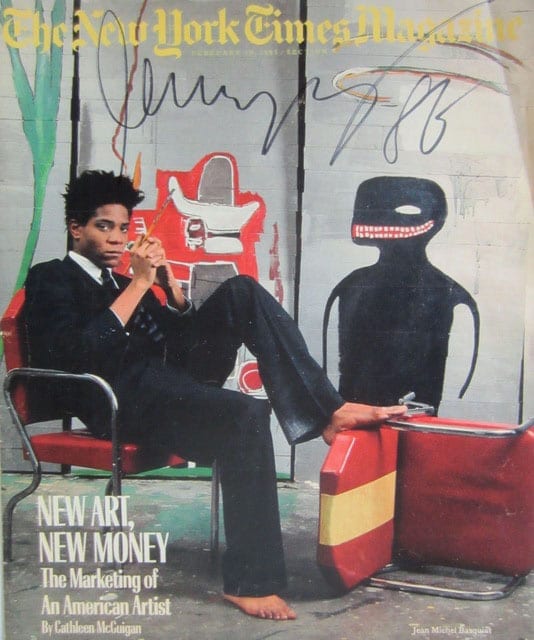
1985
In January, Basquiat has a one-artist exhibition at the Galerie Bruno Bischofberger in Zurich. Paintings shown include Max Roach, Tabac, and Zydeco.
On February 10, he appears on the cover of The New York Times magazine, posing barefoot for Cathleen McGuigan‘s extensive article,” New Art, New Money: The Marketing of American Artist.” This portrait, in comparison with the 1982 Van Der Zee photograph, arouses many questions about media hype marketing, and quality in the increasingly image-conscious art world of the 1980s, in which Basquiat proved to be a more than competent provocateur. In Van Der Zee’s frontal photograph, Basquiat comes off looking dignified, yet aggressive. In contrast, Lizzie Himmel’s photograph for The New York Times Magazine poses Basquiat with his bare foot up on a chair, coyly gazing at the viewer, the dreadlocks nicely cropped.
“To be a race-identified race-refugee is to tap-dance on a tightrope, making your precarious existence a question of balance and to whom you concede a mortgage on your mind and body and lien on your soul” (Greg Tate). 50
Photograph by: Lizzie Himmel for The New York Times Magazine, 1985
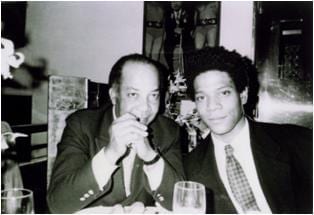
1985
Gerard Basquiat recalls his son and Warhol coming to the house that Sunday with a stack of copies to celebrate the fame and success of the twenty-four-year-old Basquiat.
“The extent of Basquiat’s success would no doubt be impossible for an artist of lesser gifts. Not only does he possess a bold sense of color and composition, but, in his best paintings, unlike many of his contemporaries, he maintains a fine balance between seemingly contradictory forces: control and spontaneity, menace and wit …. Still, the nature and rapidity of his climb is unimaginable in another era” (Cathleen McGuigan). 51
Pictured Here: Gerard and Jean-Michel Basquiat, New York, 1985 © The Estate of Jean-Michel Basquiat
1985
In March, Basquiat has his second one-artist show at the Mary Boone Gallery. In the exhibition catalogue, Robert Farris Thompson speaks of Basquiat’s art in terms of an Afro-Atlantic tradition, a context in which this art has never been discussed. Paintings in the show include Gold Griot, Grillo, Flexible, Wicker, His Glue-Sniffing Valet, and BigJoy.
“Because he is black and because he is young some critics will not be able to resist the temptation to link Basquiat to the more obvious forms of New York black and Puerto Rican street art …. In his hands black vision becomes at once private, public, didactic, playful, serious, sardonic, responsible, and, above all, deliberate …. Basquiat’s blues typography, at once interruptive and complete, makes visual black song, with equivalents to pause, shout, spacing, and breath …. Yet even here we must be wary of the claim that Basquiat signals a synthesis of the Afro-Atlantic and European artistic traditions, when his actual biography seems to speak of a graffitist sensibility of the naif that has been sophisticated by a SoHo savvy audacity” ( Robert Farris Thompson). 52
In May, on the recommendation of Henry Geldzahler, Basquiat, along with Francesco Clemente, Keith Haring, and Kenny Scharf, is commissioned to do art installations for a new club, the Palladium, on East 14th Street, opened by impressarios and Studio 54 founders, Ian Schrager and Steve Rubell. Basquiat executes two large mural-sized paintings for the Palladium’s Michael Todd Room.
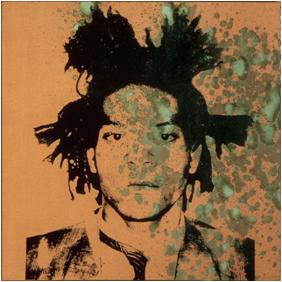
1985
Basquiat’s deteriorating health becomes more noticeable, particularly the dark spots on his face. These discolorations may have been caused by the removal of his spleen, which kept his body from cleaning out the toxins from the drugs.
“Jean-Michel was really upset about the spots and asked me and lots of other people for advice about dermatologists and treatments. I told him that if his blood was pure they’d go away. He thought it was sadly funny that Andy s oxidation portrait of him had given him spots like those on his face …. You can see lots of self-fulfilling prophesies in his work, or in the work of anybody whose work runs deep” (Glenn O ‘Brien). 53
In September, sixteen collaborative paintings by Basquiat and Warhol are shown at the Tony Shafrazi Gallery. At Shafrazi’s suggestion the two artists pose together in boxing trunks and gloves for a poster advertising the show. Unfavorable reviews cause tension in and, ultimately, weaken the Warhol-Basquiat friendship.
Pictured Here: Andy Warhol, Jean-Michel Basquiat, 1982 © The Estate of Jean-Michel Basquiat
1985
“Last year, I wrote of Jean-Michel Basquiat that he had a chance of becoming a very good painter providing he didn’t succumb to the forces that would make him an art world mascot. This year, it appears that those forces have prevailed. . . “(Vivien Raynor). 54
“Having resided over our era for considerably more than his requisite fifteen minutes, Andy Warhol keeps his star in ascendency by tacking it to the rising comets of the moment” (Eleanor Heartney). 55
In December, Basquiat spends a week in Tokyo for the opening of his one-artist show at the Akira Ikeda Gallery. That month, Annina Nosei holds an exhibition of Basquiat’s 1982 paintings.
1986
In January, Basquiat travels to Los Angeles for two weeks for his last show at the Larry Gagosian Gallery. Paintings in the show include Peruvian Maid, J’s Milagro, and Link Parabole. The following month he travels to Atlanta, his first and only trip to the South, for an exhibition of his drawings at the Fay Gold Gallery.
“He was very paranoid … being in the South. After much discussion, Jean-Michel did a news interview that he very much did not want to do ” (Fay Gold). 56
In August, Basquiat, accompanied by Jennifer Goode and her brother Eric, travels to Africa for the first time. He is joined there by Bruno Bischofberger, who, at Basquiat’s urging, has arranged for a show in Abidjan, Ivory Coast.
Relations with Mary Boone take a turn for the worse, and by the end of the year Basquiat is again without a primary dealer in New York. Problems between the equally charismatic Basquiat and Boone have been a constant part of their two-year relationship. Bischofberger continues to represent him in Europe, while trying to arrange for another New York dealer.
1986
In November, a large exhibition of more than sixty paintings and drawings opens at the Kestner-Gesellschaft in Hannover. Organized by Carl Haenlein, this is Basquiat’s second survey exhibition in a European museum; at twenty-five he is the youngest artist ever given an exhibition there.
Basquiat travels to Hamburg, where he completes his addition to Andre Heller’s traveling amusement park, Luna Luna. Along with Joseph Beuys, Salvador Dali, Sonia Delaunay, Keith Haring, David Hockney, Roy Lichtenstein, and others, Basquiat adorns carousels, funhouses, and various rides with his art.
Late in the year, Jennifer Goode and Basquiat break up. She has often complained to friends about Basquiat’s abuse of heroin, and it precipitates her decision to end their relationship. In addition to malicious gossip about Basquiat’s problems circulating through friends, growing negative criticism of his work from members of the art community does not make the situation better.

1986
Carrying the baggage of black manhood, Basquiat often correctly perceives such criticism as evidence of racism.
“He had to live up to being a young prodigy, which is a kind of false sainthood” ( Keith Haring). 57
“Being black, he was always an outsider. Even after he was flying on the Concorde, he wouldn’t be able to get a cab” (Fred Braithwaite). 58
Image Credit: Photo by © Jean Kallina.
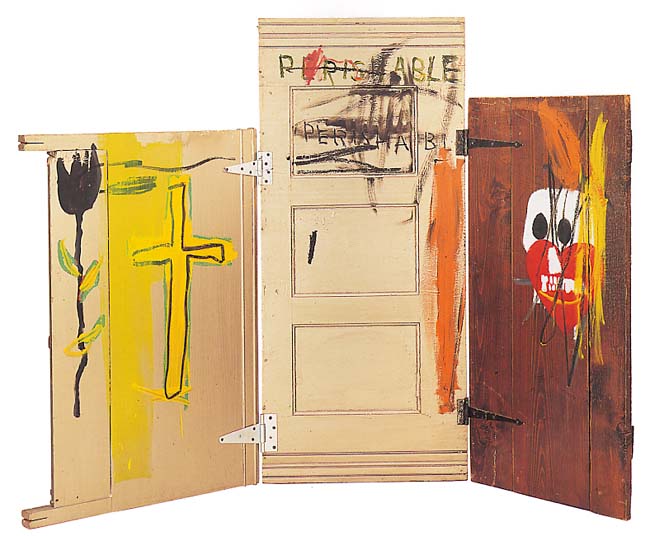
1987
In January, Basquiat has a one-artist exhibition of twelve paintings at the Galerie Daniel Templon in Paris. Some works in the exhibition are Gin Soaked Critic, Gri Gri, Mono, and Sacred Monkey.
On February 22, Andy Warhol dies. Though their friendship had suffered greatly in the last year, Basquiat appears to be devastated by this loss. Basquiat paints Gravestone, a memorial to Andy Warhol.
“It put him into a total crisis …. He couldn’t even talk” (Fred Braithwaite). 59
“The death of Warhol made the death of Basquiat inevitable, somehow Warhol was the one person that always seemed to be able to bring Jean- Michel back from the edge. Always when Jean-Michel was in the most trouble it seemed that Andy Warhol was the person who he would approach …. After Andy was gone there was no one that Jean-Michel was in such awe of that he would respond to” (Donald Rubell). 60
Pictured Here: Gravestone, 1987 Collection of Enrico Navarra © The Estate of Jean-Michel Basquiat
1987
In May, three large works on paper are shown at the Tony Shafrazi Gallery. Through Shafrazi, Basquiat meets Vrej Baghoomian, who purchases paintings and begins acting as a dealer for Basquiat’s work.
At Baghoomian’s suggestion, Rick Prol, a painter and old friend of Basquiat’s from the East Village, becomes Basquiat’s studio assistant. Basquiat begins work on paintings intended for shows in New York, Paris, and Dusseldorf the following year.
1988
Basquiat has not had an exhibition of paintings in New York for more than a year and a half, and in January, Basquiat exhibits new paintings for one night at Baghoomian’s gallery at the Cable Building in SoHo. The paintings are those being sent to shows in Paris and Dusseldorf.
Basquiat travels to Paris for his one-artist show at the Galerie Yvon Lambert. Paintings include Light Blue Movers, Riddle Me This Batman, ,,,,,,,,She Installs Confidence and Picks His Brain Like a Salad, and To Be Titled. There he meets Ouattara, a painter from the Ivory Coast residing in Paris. Ouattara invites him to come to his home in Africa after the summer. In the same month, Basquiat travels to his one-artist exhibition at the Galerie Hans Mayer in Dusseldorf.
He returns to New York for a one-artist show at the Vrej Baghoomian Gallery in April. Some critics praise the work, and it seems as if Basquiat has suddenly been redeemed. Paintings include Eroica I, Eroica II, The Dingoes That Park Their Brains with Their Gum, The Mechanics That Always Have a Gear Left Over, and Riding with Death.
1988
“Basquiat’s use of line is the way he commits to record what has been seen. Whatever your point of focus, in any given moment the work is crystal clear …. His line is the product of his mental process, the active proof of the passage from inner thought to articulation” (Demosthenes Davvetas).61
Basquiat has always been resistant to drug abuse treatment programs. In an apparent attempt to kick drugs, Basquiat leaves New York, stopping in Dallas and Los Angeles, on the way to his ranch in Hawaii.
He leaves Hawaii for New York at the end of June, stopping for a week in Los Angeles. Brian Williams, his former assistant in Los Angeles, remarks that Basquiat seems overwhelmingly happy and is proclaiming that he has kicked drugs for good.
1988
On Friday, August 12, Jean-Michel Basquiat dies in his Great Jones Street loft at age twenty-seven. The autopsy report from the office of the Chief Medical Examiner, Manhattan Mortuary, lists cause of death as “acute mixed drug intoxication (opiates- cocaine).”
On August 17, a private funeral is held at the Frank E. Campbell Funeral Chapel on Madison Avenue and 81st Street. The funeral is attended by the immediate family and close friends, including Keith Haring, Francesco Clemente, Paige Powell, and others. Jeffrey Deitch delivers the eulogy. Basquiat is buried at Greenwood Cemetery in Brooklyn.
On November 5, about three hundred of Basquiat’s friends and admirers attend a memorial gathering at St. Peter’s Church at Lexington Avenue and 54th Street. Music is played by Gray and others, poetry is recited, including a particulary moving reading by Suzanne Mallouk of A.R. Penck’s “Poem for Basquiat.”
“Jean-Michel lived like a flame. He burned really bright. Then the fire went out. But the embers are still hot” (Fred Braithwaite). 62

Self-Portrait, 1984 © The Estate of Jean-Michel Basquiat
History & Beyond
Basquiat’s life and work continues to inspire discussion, influence generations of artists and art in all its forms and make history all around the world. View the Events section to learn more about notable press and upcoming events regarding his work and legacy.
Footnotes
Chronology from exhibition “Jean-Michel Basquiat” at the Whitney Museum of American Art, New York October 23, 1992-February 14, 1993
Compiled by M. Franklin Sirmans
1 - 20
- Gerard Basquiat, interview with the author, February 4, 1992.
- Quoted in Steven Hager, Art After Midnight: The East Village Scene (New York: St. Martin’s Press, 1986), p. 39.
- Gerard Basquiat, interview.
- Ibid.
- Gerard Basquiat, interview.
- Quoted in Suzi Gablik, “Report from New York: The Graffiti Question,” Art in America, 70 (October 1982), p. 36.
- Al Diaz, interview with the author, March 2, 1992.
- Quoted in Philip Faflick, “SAMO© Graffiti: BOOSH-WAH OR CIA?” The Village Voice, December 11, 1978.
- Quoted in Champions, exh. cat. (New York: Tony Shafrazi Gallery, 1983), p. 16.
- Gerard Basquiat, interview.
- Cathleen McGuigan, “New Art, New Money: The Marketing of an American Artist,” The New York Times Magazine, February 10, 1985, p. 29.
- Edit DeAk, interview with author, February 19, 1992.
- Henry Geldzahler, interview with author, March 16, 1992.
- Mary Ann Monforton, interview with author, January 31, 1992.
- Fred Braithwaite (Fab 5 Freddy), foreword to Havelock Nelson and Michael A. Gonzales, Bring the Noise: A Guide to Rap Music and Hip-Hop Culture (New York: Harmony Books, 1991).
- Quoted in Hager, Art After Midnight, p. 40.
- Lenny McGurr (Futura 2000), interview with the author, March 17, 1992.
- Suzanne Mallouk, interview with the author, February 12, 1992.
- Faflick, “SAMO Graffiti.”
- Diaz, interview.
21 - 40
21. Michael Holman, interview with the author, January 30, 1992.
22. Glenn O’Brien, interview with author, February 19, 1992.
23. Jeffrey Deitch, “Report from Times Square,” Art in America, 68 (September 1980), p. 61.
24. Gerard Basquiat, interview.
25. Rene Ricard, “The Radiant Child,” Artforum, 20 (December 1981), pp. 42-43.
26. Shenge Kapharoah, interview with the author, February 6, 1992.
27. Lisa Liebmann, “Jean-Michel Basquiat: Annina Nosei,” Art in America, 70 (October 1982), p. 130.
28. Jeffrey Deitch, “Jean-Michel Basquiat: Annina Nosei,” Flash Art, 16 (May 1982), p. 50.
29. William Wilson, “N.Y. Subway Graffiti: All Aboard For L.A.,” Los Angeles Times, April 16, 1982.
30. Noel Frackman and Ruth Kaufmann, “Documenta 7: The Dialogue and a Few Asides,” Arts Magazine, 57 (October 1982), p. 97.
31. Quoted in McGuigan, “New Art, New Money,” p. 74.
32. Susan Hapgood, “Jean-Michel Basquiat: Fun Gallery,” Flash Art, no. 111 (March 1983), pp, 58-59.
33. Nicolas A. Moufarrege, “East Village,” Flash Art, no. 111 (March 1983), pp. 36-41.
34. Kapharoah, interview.
35. Pat Hackett, ed., The Andy Warhol Diaries (New York: Warner Books, 1989), p. 492.
36. Ibid., p. 603.
37. McGuigan, “New Art, New Money,” p. 28.
38. Hackett, The Andy Warhol Diaries, p. 525.
39. Quoted in Anthony HadenGuest, “Burning Out,” Vanity Fair (November 1988), pp. 180-98.
40. Recounted in Mallouk, interview
41 - 61
41. Hackett, The Andy Warhol Diaries, p. 545.
42. Quoted in Henry Geldzahler, “Art: From Subways to SoHo, Jean-Michel Basquiat,” Interview, 13 (January 1983), pp. 44-46.
43. Mallouk, interview.
44. Paige Powell, interview with the author, March 9, 1992.
45. Quoted in Ellen Lubell, “New Kid on the (Auction) Block,” The Village Voice, May 29, 1984, p. 45.
46. Vivien Raynor, “Art: Paintings by Jean-Michel Basquiat at Boone,” The New York Times, May 11, 1984, p. 26.
47. Kate Linker, “Jean-Michel Basquiat,” Artforum, 23 (October 1984), p. 91.
48. Melode Ferguson, interview with the author, March 23, 1992.
49. Hackett, The Andy Warhol Diaries, p. 584.
50. Greg Tate, “Nobody Loves A Genius Child: Jean-Michel Basquiat, Lonesome Flyboy in the ‘80s Art Boom Buttermilk,” The Village Voice, November 14, 1989, pp. 31-35.
51. McGuigan, “New Art, New Money,” p. 54.
52. Robert Farris Thompson, “Activating Heaven: The Incantatory Art of Jean-Michel Basquiat,” in Jean-Michel Basquiat, exh. cat. (New York: Mary Boone-Michael Werner Gallery, 1985), n.p.
53. Glen O’Brien, “Memo,” in Jean-Michel Basquiat, exh. Cat. (New York: Vrej Baghoomian Gallery, 1989), p. 93.
54. Vivien Rayno, “Art: Basquiat, Warhol,” The New York Times, September 20, 1985, p. 91.
55. Eleanor Heartney, “Basquiat, Warhol,” Flash Art, no. 125 (December 1985-January 1986), p. 43.
56. Fay Gold, interview with the author, April 13, 1992.
57. Quoted in Phoebe Hoban, “SAMO© …Is Dead: The Fall of Jean-Michel Basquiat,” New York, September 26, 1988, p. 43.
58. Quoted in ibid., p. 44.
59. Quoted in ibid., p. 43.
60. Geoff Dunlop, “Jean-Michel Basquiat: Shooting Star” (videotape). London: Illuminations Production, 1990.
61. Demosthenes Davvetas, “Lines, Chapters, and Verses: The Art of Jean-Michel Basquiat,” Artforum, 25 (April 1987), p. 120.
Quoted in Hoban, “SAMO Is Dead,” p. 44.

